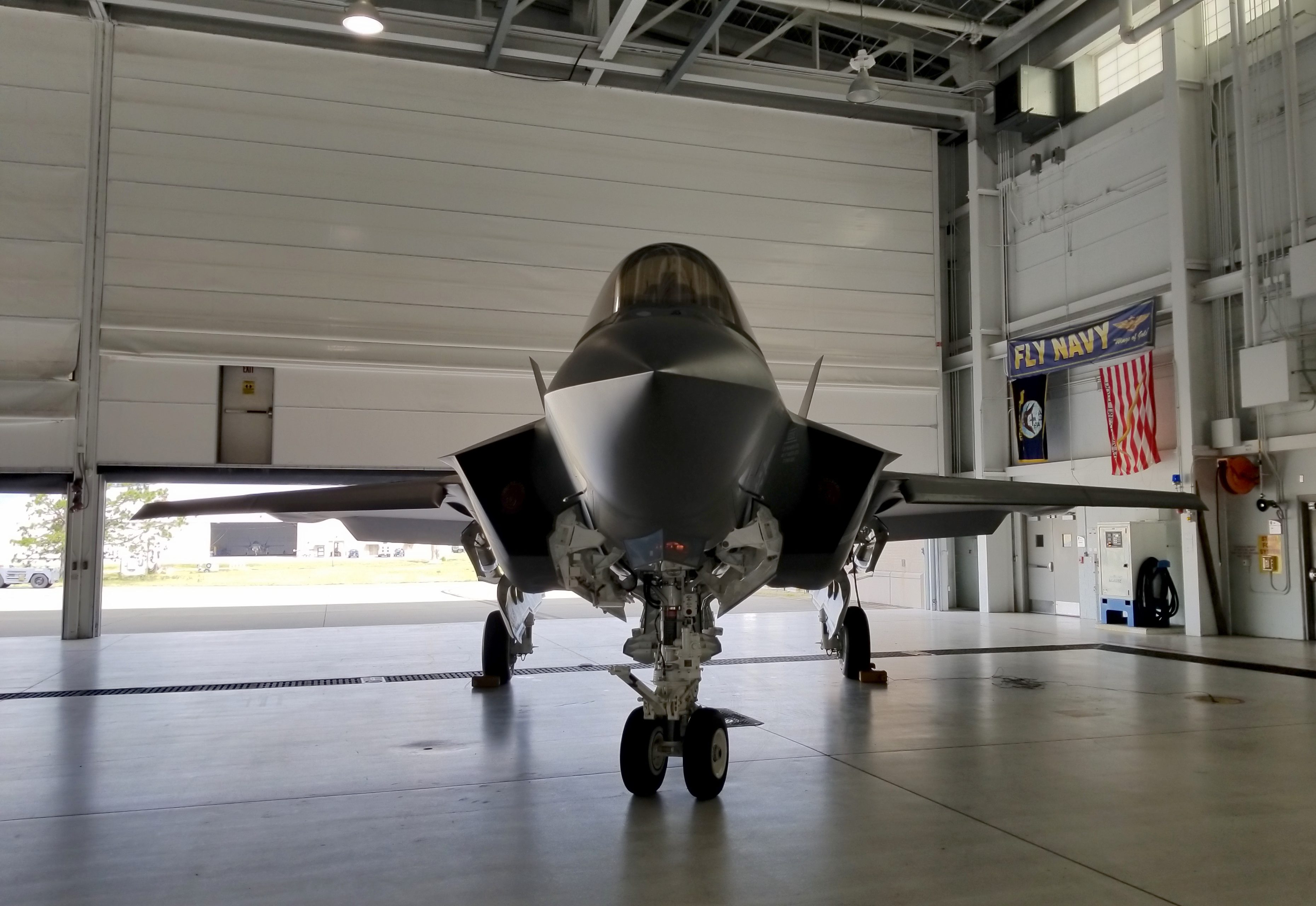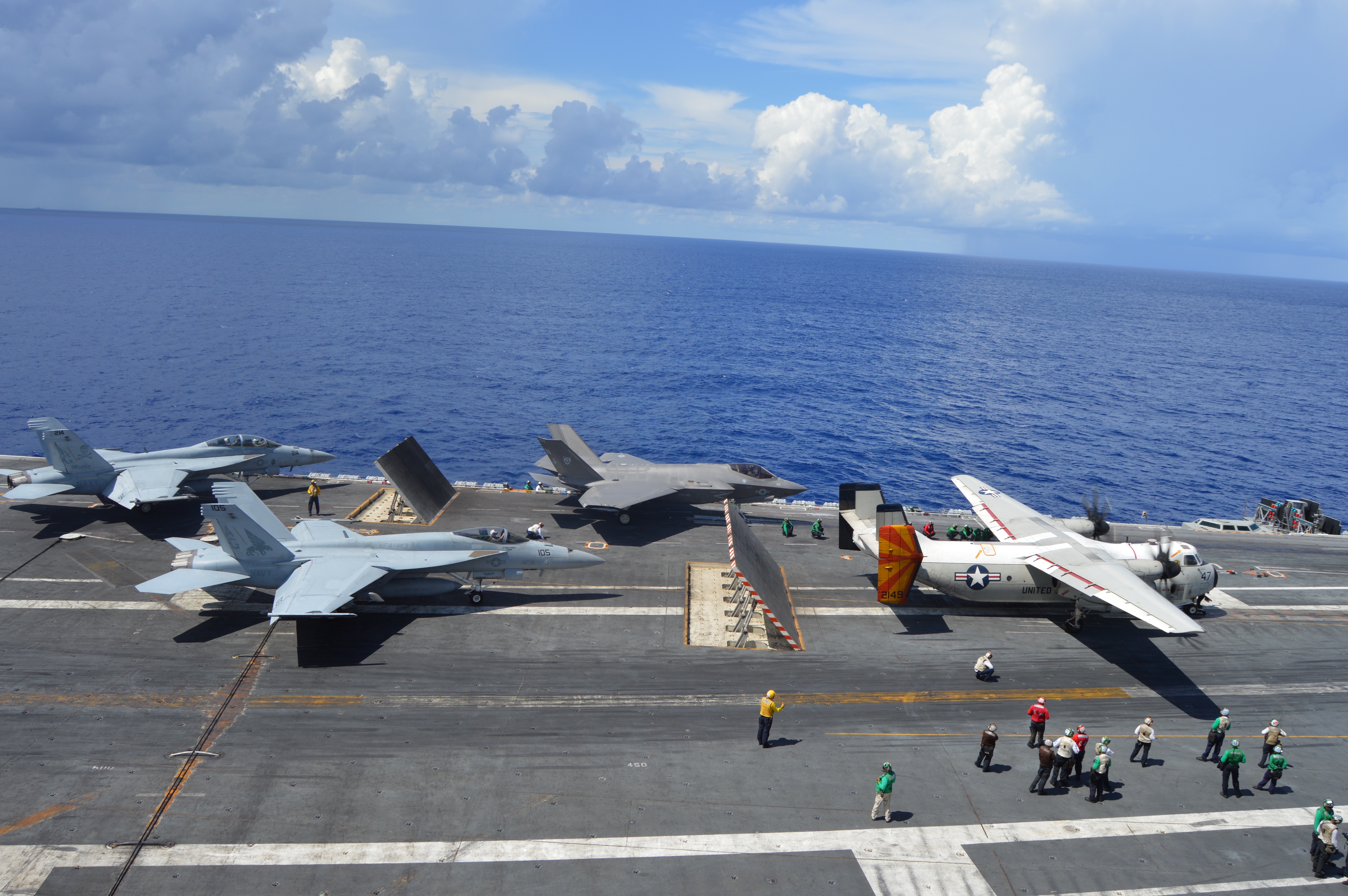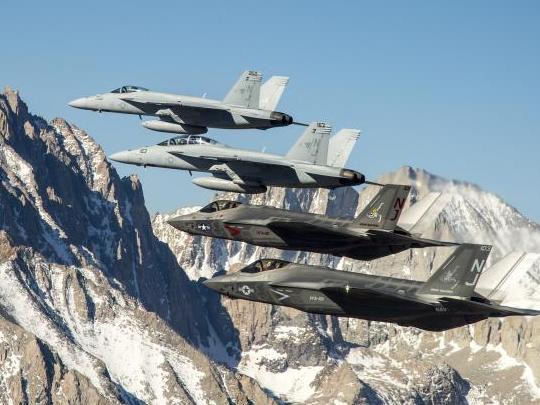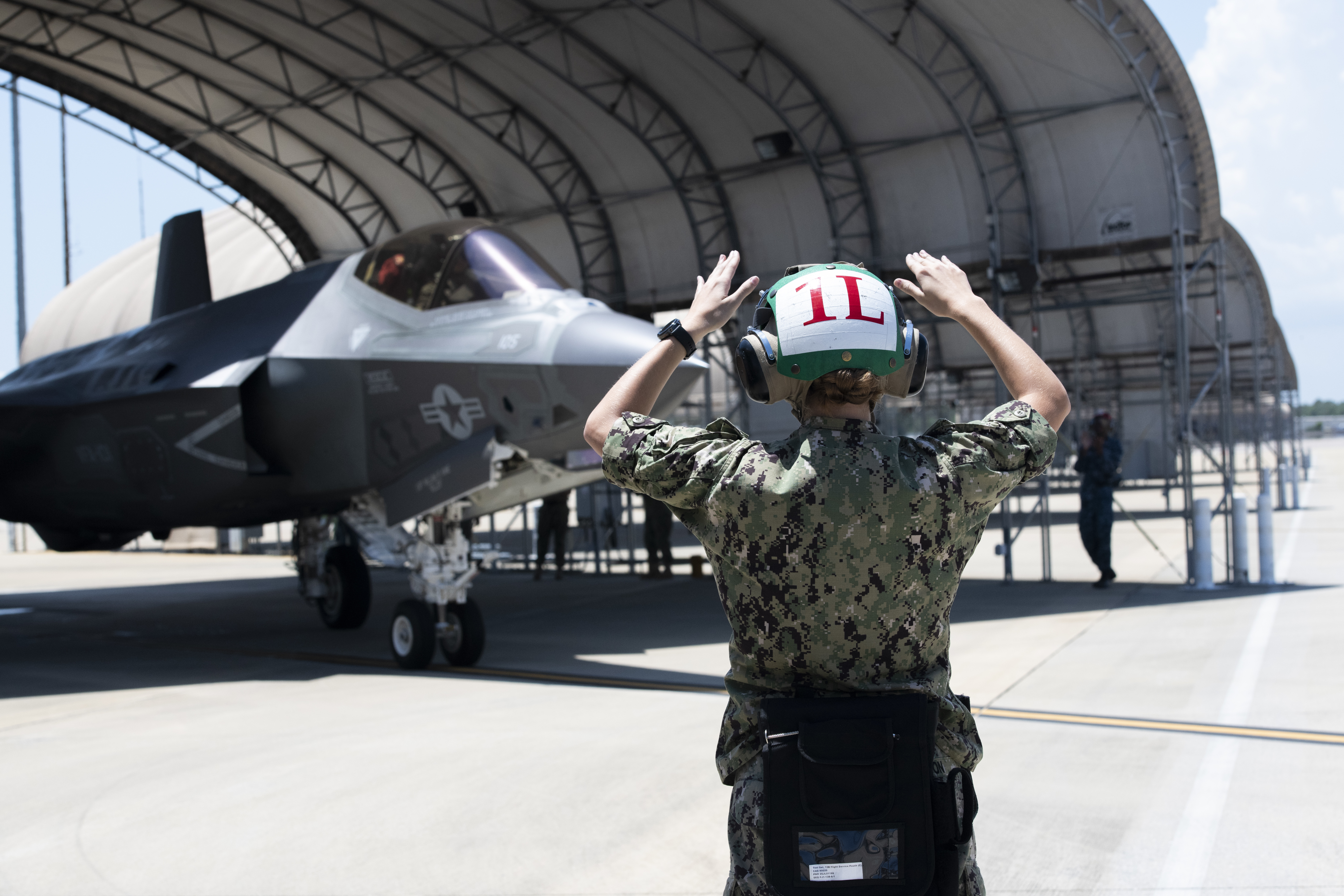A U.S. Navy Sailor marshals the last F-35C Lightning II to leave Eglin Air Force Base, Florida, May 23, 2019. Consolidation of F-35C resources to Naval Air Station Lemoore, California, enables the U.S. Navy to support Fleet Replacement Squadron (FRS) production, operational fleet transitions for both Navy and Marine Corps squadrons, testing and other requirements. US Air Force photo.
EGLIN AIR FORCE BASE, Fla. – The Navy deactivated one of its two F-35C Joint Strike Fighter training squadrons today and will consolidate all its fifth-generation fighter activities at Naval Air Station Lemoore in California.
The move creates efficiencies on the maintenance side and allows the Navy to focus on getting its first operational F-35C squadron on deployment and integrated with its fourth-generation counterparts in the carrier air wing.
The “Grim Reapers” of Strike Fighter Squadron (VFA) 101 stood up in the spring of 2012 as the very first F-35C squadron. They were based at Eglin AFB alongside the Air Force’s F-35A community, which was farther along in development and already had some experience with the fifth-gen F-22 fighters.
The Navy decided last year that the Grim Reapers, which trace their lineage back to World War II, would be deactivated for the third time. VFA-101 would send its personnel and aircraft to VFA-125, the other FRS squadron already set up in Lemoore with the rest of the Navy’s strike fighter community.
During the fall and winter, the two squadrons worked together multiple times as an integrated FRS team, and Cmdr. Adan Covarrubias, commanding officer of VFA-101 who will take command of VFA-125 next month, told USNI News after the deactivation ceremony that “it was probably the best thing we could have ever done.”
“We integrated (VFA) 125 maintenance practices into what we were doing, and then vice versa, (VFA) 101 into 125. We kind of took the best of everything, figured out what worked for everybody, and then came up with the best process,” he said.
Covarrubias himself will lead the single, larger FRS squadron, and many of his maintainers and pilots from VFA-101 are coming out to Lemoore with him in an effort to keep as much F-35C knowledge in the community as possible.
Thanks to the early integration work, “it’s kind of been seamless. When we transition to 125 here in a couple weeks, everybody knows each other, everybody’s worked with each other in the past,” he continued. “We’ve been working this for about a year now, and we’ve worked really well together.”
VFA-101 trained its last pilot in March and April and has slowly been sending its aircraft and gear out to Lemoore, Covarrubias said. The last two jets remaining in the squadron flew off the Eglin AFB flight line for the last time today and headed for California.

Strike Fighter Squadron VFA-101 had just two F-35C Joint Strike Fighter jets remaining on May 23, 2019, when the squadron deactivated. The two jets flew off the Eglin Air Force Base flight line for the last time and headed for Naval Air Station Lemoore, Calif., where all F-35C activities will be consolidated. USNI News photo.
Capt. Max McCoy, commodore of the Joint Strike Fighter Wing in Lemoore, told USNI News in a Wednesday interview ahead of the deactivation ceremony that setting up early F-35C efforts alongside the Air Force at Eglin proved to be a very smart decision. The service had already learned a lot about maintaining the new jets and had established a collaboration with Lockheed Martin experts on the base.
But, he said, as the Navy became fully focused on getting its first operational squadron, VFA-147, on its first deployment in a carrier air wing, it became clear last year that consolidating at Lemoore was the right move.
“It gives us that shock absorber that we need to ensure that VFA-147 has everything it needs to go through workups and get to deployment. Moving forward, that is my number-one priority,” McCoy said.
McCoy said VFA 147 is exactly where it should be ahead of its planned 2021 deployment with Carrier Air Wing 2 aboard USS Carl Vinson (CVN-70). Maintenance personnel are building up their capabilities, but at this stage the squadron has only received two junior pilots out of flight school and is still awaiting more senior pilots who are transitioning to the F-35C from other aircraft types. So, efficient pilot production is the name of the game to keep VFA-147 on schedule – and deactivating VFA-101 and consolidating all FRS activities to VFA-125 in Lemoore will help the Navy do that.
“When you have more maintenance personnel and you have more aircraft, it gives you the capability to fly more sorties on a given fly-day on the schedule. You now have spare aircraft that can be turned into flyers if you need them. Because you have more maintenance personnel, you can work a longer maintenance shift, or you can work more days,” McCoy explained.
“Having one large FRS gives us the flexibility to do more and to weather those moments where there’s unexpected or pop-up requirements. When you’re spread thin with people and airplanes, it just makes it more challenging and there is no buffer to cover down on executing the flight schedule.”
Additionally, for the long-term health of the F-35C force, “when we have all of our people and airplanes in one place, it allows us to balance sea-shore rotations with sailors and officers and pilots, because now it’s easier to flow folks from an operational tour to a shore tour, whether that’s working at the [Fleet Replacement Squadron] or at the wing.”

An F-35C Lighting II Joint Strike Fighter prepares to launch from USS Abraham Lincoln (CVN-72) on Monday during operations in the Atlantic. USNI News Photo
In addition to those benefits to the F-35C community, the consolidation of all F-35C assets to a home base in Lemoore signals that the F-35 is fully integrated into the heart of naval aviation’s strike fighter community.
McCoy told USNI News that fully integrating the F-35s with the F/A-18E-F Super Hornets and EA-18G Growlers they’ll be flying with off carrier decks, as well as the E-2D Advanced Hawkeyes and the MH-60 helicopters in the air wing, is “absolutely critical” before the first deployment.
With Carrier Air Wing 2 already set up at Lemoore, its F-18 squadrons will be able to interact with VFA-147 on a daily basis beginning this year, ahead of the 2021 deployment.
“The integration between those two platforms is the building block to the integration of the carrier air wing and the carrier strike group,” McCoy said of the F-18s and the F-35s. “Sharing a flight line is absolutely critical to maturing and accelerating the capabilities of the strike fighter community.”
The commodore said he hopes the growing presence of the F-35C in Lemoore will normalize the new plane – whose stealthy design and dark gray coloring is noticeably different from the other jets parked on a flight line or on a carrier deck.
“Not only do they get to see it up close on the ground, but flying alongside it airborne in those integrated events will really allow people to see the capability of the airplane,” McCoy said.
There’s still plenty of work to be done on concepts of operations, McCoy said, but “I have a very optimistic outlook in the sense that I think we’re going to really appreciate what F-35 brings to a carrier strike group – and I think that not only aviators but the other warfare commanders will fully appreciate those same capabilities.”

Three F-35C Lightning II — one each attached to the “Argonauts” of Strike Fighter Squadron (VFA) 147, the “Rough Raiders “Strike Fighter Squadron (VFA) 125 and the “Grim Reapers” Strike Fighter Squadron (VFA) 101 — complete a flight overhead Eglin Air Force Base in Fort Walton Beach, Fla., Feb. 1, 2019. US Navy photo.
Rear Adm. Roy Kelley, commander of Naval Air Force Atlantic, spoke at the deactivation ceremony both as a naval aviation leader and as a former Grim Reapers pilot, back when the squadron flew the F-14 Tomcat. Kelley previously served as the director of the Joint Strike Fighter Fleet Integration Office and said he was pleased to see this day come after some earlier delays in fielding the F-35C.
“It was a rocky road. It wasn’t a path that was direct and easy; it was evident we were going to have some challenges. The Navy had an idea or a concept of what we wanted for the capability, and so the type of software we wanted for those capabilities meant we had to wait a little bit,” Kelley told USNI News after the ceremony, referring to the Block 3F software that the Marine Corps moved ahead without on its F-35B but the Navy waited for on the F-35C.
“That (delay) challenged us as we looked at our inventory of aircraft that we had, the fighter aircraft onboard an aircraft carrier. So we continue to buy Super Hornets, and a lot of people ask questions about, why are you doing that?” Kelley continued.
“It’s because we want a mix. We want the capabilities that we have with the Super Hornets right now; we want fifth-generation capability in the future. We see those working together. The concept that we have is that the F-35 is truly going to be the quarterback for the carrier air wing, with the systems it has onboard, the fusion it’s capable of, of bringing information together. It’s significant. So having them being the eyes and ears and the directors as we move the carrier air wing forward is important.”
Asked if the capability the F-35C brings was worth the wait, Kelley replied, “yeah, it was, there’s no doubt about it.”

Two F-35C Lightning II aircraft fly in formation over the Sierra Nevada mountain range with to two F/A-18E/F Super Hornets. US Navy Photo
During the ceremony, Kelley spoke of adversaries’ fifth-generation fighters – the Russian Su-57E that “may not be the quality or the capability of what you see behind you (with the F-35C), but it’s still a threat” and could become more prevalent as Russia seeks to sell it internationally, as well as the Chinese J-20 that has powerful sensors, long-range missiles and a stealthy design.
“Our Navy and our nation need this aircraft now, and your efforts have been instrumental in getting us to this important moment in history. This is a historic moment, because for the first time in decades we could see the balance of power shift as China and Russia appear determined to reshape the world order,” he said to the VFA-101 personnel at the ceremony, adding that “the F-35 is indeed the right aircraft at the right time.”
Understanding what’s at stake as the F-35C community continues to mature and prepares for its first operational deployment, Kelley told USNI News, “we’re excited about the integration. And as we move forward, there’s some challenges, no doubt. How do we integrate this appropriately? How do we use all the capabilities that the F-35 has, so that we can move forward with the carrier air wing of the future?”

